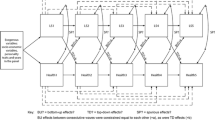Abstract
Marketers and consumer researchers have maintained a long-standing interest in understanding continuities and changes in consumer preferences. The present research attempts to provide explanations for stability and changes in consumption patterns by presenting a theoretical framework according to which the results of previous studies may be recast and further research advanced. The authors develop hypotheses and test them with retrospective and longitudinal data, using alternate measures of key variables. The authors suggest implications of the study findings for marketers and theory development, and they provide directions for future research.

Similar content being viewed by others
References
Andreasen, A. R. (1984). Life status changes and changes in consumer preferences and satisfaction. Journal of Consumer Research, 11, 784–794.
Aneshensel, C. S. (1992). Social stress theory and research. Annual Review of Sociology, 18, 15–38.
Chiriboga, D. A. (1989). The measurement of stress exposure in later life. In K. S. Markides & C. L. Cooper (Eds.), Aging stress and health (pp. 13–41). New York: Wiley.
Cohen, L. H. (1988). Life events and psychological functioning. Newbury Park, CA: Sage.
Elder, G. H., Jr., George, L. K., & Shanahan, M. J. (1996). Psychological stress over the life course. In Psychological stress perspectives on structure, theory, life course, and methods (pp. 247–292). Orlando, FL: Academic.
Escalas, J. E., & Bettman, J. R. (2003). You are what they eat: The influence of reference groups on consumers connections to brands. Journal of Consumer Psychology, 13(3), 339–348.
Faber, R. J., Christenston, G. A., De Zwann, M. D., & Mitchell, J. (1995). Two forms of compulsive consumption: Comorbidity of compulsive buying and binge eating. Journal of Consumer Research, 22, 296–304.
Gentry, J. W., Kennedy, P. F., Paul, C., & Hill, R. P. (1995). Family transitions during grief: Discontinuities in household consumption patterns. Journal of Business Research, 34, 67–79.
George, L. K. (1989). Stress, social support, and depression over the life-course. In K. S. Markides & C. L. Cooper (Eds.), Aging, stress and health (pp. 241–267). New York: Wiley.
Gierveld, J. J., & Dykstra, P. A. (1993). Life transitions and the network of personal relationships: Theoretical and methodological issues. Advances in Personal Relationships, 4, 195–227.
Herbert, T. B., & Cohen, S. (1996). Measurement issues in research on psychological stress. In B. K. Howard (Ed.), Psychological stress: Perspectives of structure, theory, life course, and methods (pp. 295–332) San Diego, CA: Academic.
Hirschman, E. C. (1992). The consciousness of addiction: Toward a general theory of compulsive consumption. Journal of Consumer Research, 19, 155–179.
Jenkins, C. D., Hurst, M. W., & Rose, R. M. (1979). Life changes: Do people really remember? Archives of General Psychiatry, 36, 379–384.
Kotler, P. (1992). Marketing management. Englewood Cliffs, NJ: Prentice-Hall.
Krause, N. (1989). Issues of measurement and analysis in studies of social support, aging and health. In K. S. Markides & C. L. Cooper (Eds.), Aging, stress and health (pp. 43–66). New York: Wiley.
Larson, J. (1993). Getting professional help. American Demographics, 15, 34–38 (July).
Lazarus, R., & Folkman, S. (1984). Stress appraisal, and coping. New York: Springer.
Lee, E., Moschis, G. P., & Mathur, A. (2001). A study of life events and changes in patronage preferences. Journal of Business Research, 54, 25–38.
MacKinnon, D. P., Lockwood, C. L., Hoffman, J. M., West, S. G., & Sheets, V. (2002). A comparison of methods to test mediation and other intervening variables. Psychological Methods, 7(1), 83–104.
Madill-Marshall, L. H., & Duxbury, L. (1995). Coping with household stress in the 1990s: Who uses convenience foods and do they help? In F. R. Kardes & M. Sujan (eds.), Advances in Consumer Research, Vol. 22 (pp. 729–734). Provo, UT: Association for Consumer Research.
Mathur, A., Lee, E., & Moschis, G. P. (2006). Life-changing events and marketing opportunities. Journal of Targeting, Measurement, and Analysis in Marketing, 14(2), 115–128.
Mathur, A., Moschis, G. P., & Lee, E. (2003). Life events and brand preference changes. Journal of Consumer Behavior, 3(2), 129–141.
McAlexander, J. H., Schouten, J. W., & Roberts, S. D. (1993). Consumer behavior and divorce. In J. A. Costa & R. W. Belk (Eds.), Research in Consumer Behavior, Vol. 6 (pp. 153–184). Greenwich, CT: JAI.
Mergenhagen, P. (1995). Targeting transitions: Marketing to consumers during life changes. Ithaca, NY: American Demographics.
Mortimer, J. T., & Shanahan, M. J. (Eds.) (2003). Handbook of the life course. New York: Plenum.
Moschis, G. P. (2007). Life course perspectives on consumer behavior. Journal of the Academy of Marketing Science, in press.
Norris, F. H., & Uhl, G. A. (1993). Chronic stress as a mediator of acute stress: The case of hurricane Hugo. Journal of Applied Social Psychology, 23(16), 1263–1284.
O’Guinn, T. C., & Faber, R. J. (1991). Mass communication and consumer behavior. In T. S. Robertson & H. H. Kassarjian (Eds.), Handbook of consumer behavior (pp. 349–400), Englewood Cliffs, NJ: Prentice-Hall.
O’Guinn, T. C., & Faber, R. J. (1989). Compulsive buying: A phenomenological exploration. Journal of Consumer Research, 16, 147–157.
Pearlin, L. I. (1982). Discontinuities in the study of aging. In T. K. Hareven & K. J. Adams (Eds.), Aging and life course transitions: An interdisciplinary perspective (pp. 55–74). New York: Guilford.
Pearlin, L. I. (1989). The sociological study of stress. Journal of Health and Social Behavior, 30, 241–256.
Pearlin, L. I., Lieberman, M. A., Menaghan, E. G., & Mullan, J. T. (1981). The stress process. Journal of Health and Social Behavior, 22, 337–356.
Rodgers, W., & Hertzog, A. R. (1987). Interviewing older adults: The accuracy of factual information. Journal of Gerontology, 42, 387–394.
Russell, C. (1995). The baby boom turns 50. American Demographics, 17, 22–33.
Schewe, C. D., & Balazs, A. L. (1992). Role transitions in older adults: A marketing opportunity. Psychology and Marketing, 9, 85–99.
Schewe, C. D., & Meredith, G. E. (1994). Digging deep to delight the older consumer. Marketing Management, 3(3), 21–35.
Silvers, C. (1997). Smashing old stereotypes of 50-plus America. Journal of Consumer Marketing, 14(4, 5), 303–309.
Tausig, M. (1982). Measuring life events. Journal of Health and Social Behavior, 23, 52–64.
Thoits, P. (1995). Stress, coping, and social support processes: Where are we? What next? Journal of Health and Social Behavior, 36, 53–79.
Wheaton, B. (1990). Life transitions, role histories, and mental health. American Sociological Review, 55, 209–223.
Zisook, S., Shuchter, S., & Mulvihill, M. (1990). Alcohol, cigarette, and medication use during the first year of widowhood. Psychiatric Annals, 20(6), 318–326.
Acknowledgements
The authors thank Fran H. Norris for her helpful suggestions at early stages of this research; Danny N. Bellenger for his comments on early drafts; the assistance of four anonymous JAMS reviewers; and Sharon Sullivan for her help in preparing this manuscript. This research was supported in part by a summer research grant to the first author from the Frank G. Zarb School of Business, Hofstra University.
Author information
Authors and Affiliations
Corresponding author
Appendices
Appendix A
Appendix B
Rights and permissions
About this article
Cite this article
Mathur, A., Moschis, G.P. & Lee, E. A longitudinal study of the effects of life status changes on changes in consumer preferences. J. of the Acad. Mark. Sci. 36, 234–246 (2008). https://doi.org/10.1007/s11747-007-0021-9
Received:
Accepted:
Published:
Issue Date:
DOI: https://doi.org/10.1007/s11747-007-0021-9




